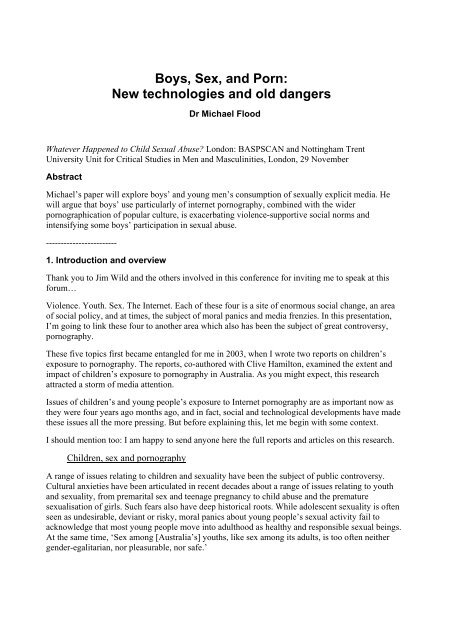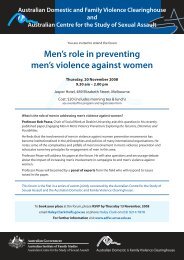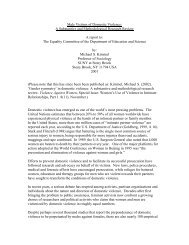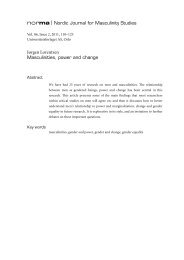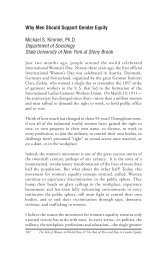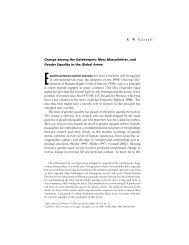Boys, Sex, and Porn: New technologies and old dangers - XY online
Boys, Sex, and Porn: New technologies and old dangers - XY online
Boys, Sex, and Porn: New technologies and old dangers - XY online
You also want an ePaper? Increase the reach of your titles
YUMPU automatically turns print PDFs into web optimized ePapers that Google loves.
<strong>Boys</strong>, <strong>Sex</strong>, <strong>and</strong> <strong>Porn</strong>:<br />
<strong>New</strong> <strong>technologies</strong> <strong>and</strong> <strong>old</strong> <strong>dangers</strong><br />
Dr Michael Flood<br />
Whatever Happened to Child <strong>Sex</strong>ual Abuse? London: BASPSCAN <strong>and</strong> Nottingham Trent<br />
University Unit for Critical Studies in Men <strong>and</strong> Masculinities, London, 29 November<br />
Abstract<br />
Michael’s paper will explore boys’ <strong>and</strong> young men’s consumption of sexually explicit media. He<br />
will argue that boys’ use particularly of internet pornography, combined with the wider<br />
pornographication of popular culture, is exacerbating violence-supportive social norms <strong>and</strong><br />
intensifying some boys’ participation in sexual abuse.<br />
------------------------<br />
1. Introduction <strong>and</strong> overview<br />
Thank you to Jim Wild <strong>and</strong> the others involved in this conference for inviting me to speak at this<br />
forum…<br />
Violence. Youth. <strong>Sex</strong>. The Internet. Each of these four is a site of enormous social change, an area<br />
of social policy, <strong>and</strong> at times, the subject of moral panics <strong>and</strong> media frenzies. In this presentation,<br />
I’m going to link these four to another area which also has been the subject of great controversy,<br />
pornography.<br />
These five topics first became entangled for me in 2003, when I wrote two reports on children’s<br />
exposure to pornography. The reports, co-authored with Clive Hamilton, examined the extent <strong>and</strong><br />
impact of children’s exposure to pornography in Australia. As you might expect, this research<br />
attracted a storm of media attention.<br />
Issues of children’s <strong>and</strong> young people’s exposure to Internet pornography are as important now as<br />
they were four years ago months ago, <strong>and</strong> in fact, social <strong>and</strong> technological developments have made<br />
these issues all the more pressing. But before explaining this, let me begin with some context.<br />
I should mention too: I am happy to send anyone here the full reports <strong>and</strong> articles on this research.<br />
Children, sex <strong>and</strong> pornography<br />
A range of issues relating to children <strong>and</strong> sexuality have been the subject of public controversy.<br />
Cultural anxieties have been articulated in recent decades about a range of issues relating to youth<br />
<strong>and</strong> sexuality, from premarital sex <strong>and</strong> teenage pregnancy to child abuse <strong>and</strong> the premature<br />
sexualisation of girls. Such fears also have deep historical roots. While adolescent sexuality is often<br />
seen as undesirable, deviant or risky, moral panics about young people’s sexual activity fail to<br />
acknowledge that most young people move into adulthood as healthy <strong>and</strong> responsible sexual beings.<br />
At the same time, ‘<strong>Sex</strong> among [Australia’s] youths, like sex among its adults, is too often neither<br />
gender-egalitarian, nor pleasurable, nor safe.’
Public concerns about young people’s exposure to pornography have been prompted in part by six<br />
shifts in young people’s sexual lives over the last few decades.<br />
Other shifts in the sexual lives of young people<br />
First, children in Western countries are now starting puberty <strong>and</strong> adolescence earlier <strong>and</strong> staying in<br />
it for longer than ever before. Second, the average age of first intercourse has declined. Third,<br />
younger people engage in a wider variety of sexual behaviours than <strong>old</strong>er people, including oral sex<br />
<strong>and</strong> anal intercourse. Fourth, young people now have a greater number of sexual partners. Fifth,<br />
some young people are participating in an increasingly visible gay <strong>and</strong> lesbian community, <strong>and</strong> from<br />
Australian studies, about one in ten secondary school students is sexually attracted either to the same<br />
sex only or to both sexes. Finally, today’s children are growing up in a sexualised cultural<br />
environment. Late twentieth-century Western cultures saw a proliferation of sexual imagery <strong>and</strong> an<br />
explosion of popular sexual debate.<br />
<strong>Sex</strong>ualisation of contemporary culture. Media’s role in (informal) sexuality education.<br />
Today’s children are growing up in a very different cultural environment: sexual imagery is more<br />
common <strong>and</strong> sex is part of popular discussion.<br />
The mass media plays a powerful role in the socialisation of children <strong>and</strong> adolescents (G<strong>old</strong>man<br />
2000, p. 16). In fact, the media may be particularly important in shaping young people’s sexual<br />
knowledge, attitudes, <strong>and</strong> behaviours in that they have limited access to other sources of sexual<br />
information. Parents seldom provide detailed information <strong>and</strong> communicate about sexuality-related<br />
topics only with difficulty, while school sexuality education often focuses on biology <strong>and</strong> neglects<br />
sexual behaviour, romance <strong>and</strong> interpersonal relations.<br />
Given the increasing sexualisation or ‘pornographication’ of mainstream media, X-rated movies <strong>and</strong><br />
‘adult’ websites are hardly the only sources of young people’s encounters with sexually explicit<br />
representations. Still, I focus on pornography because it is at the centre of contemporary debates<br />
regarding youth <strong>and</strong> sexually explicit representations.<br />
So, what is pornography?<br />
What is pornography?<br />
<strong>Porn</strong>ography can be defined as ‘sexually explicit media that are primarily intended to sexually<br />
arouse the audience’ (Malamuth 2001, p. 11817). ‘<strong>Sex</strong>ually explicit’ representations include images<br />
of female or male nudity or semi-nudity, implied sexual activity, <strong>and</strong> actual sexual activity.<br />
I use the term ‘pornography’ as a neutral term, rather than as a negative term referring to<br />
representations of bodies <strong>and</strong> sexual activity which are offensive, obscene, or harmful.<br />
2. Exposure of youth to pornography<br />
2.1 Paths to exposure<br />
How are children <strong>and</strong> young people exposed to pornography?<br />
First, children may deliberately seek sexually explicit materials. They do this for reasons which<br />
overlap with those of adults: curiosity, interest in sexual <strong>and</strong> reproductive health, interest in<br />
2
information which may benefit their interpersonal relations, <strong>and</strong> a desire for sexual stimulation. On<br />
the Internet, minors may search for sexually explicit material using a search engine, go to a<br />
particular web site, use a chat room, or sign up to a sexual mailing list.<br />
Second, young people are exposed to pornography accidentally. On the Internet, it is easy for<br />
children <strong>and</strong> indeed all Internet users inadvertently to encounter pornography.<br />
In this discussion, the term ‘exposure’ refers to both deliberate <strong>and</strong> accidental, voluntary <strong>and</strong><br />
involuntary, viewing of pornography.<br />
Legally, minors’ lack of access to sexually explicit materials is very clear. Individuals under 18<br />
years cannot purchase or view R- <strong>and</strong> X-rated films <strong>and</strong> videos <strong>and</strong> publications. And neither<br />
children nor adults can view ‘Refused Classification’ materials.<br />
But on the Internet, it is child’s play to see sexually explicit materials. This is because of three<br />
distinct characteristics of Internet pornography.<br />
The Internet hosts an enormous variety of free pornography.<br />
First, sexually explicit material is available free in mammoth quantities. Commercial websites<br />
routinely include free images <strong>and</strong> tours to entice people to subscribe, while the Internet also hosts<br />
large collections of free pornographic images <strong>and</strong> movies. While children have sought out sexual<br />
material for a long time, the Internet makes doing so easier, faster, <strong>and</strong> more anonymous<br />
(Strasburger & Wilson 2002: 308-309). A curious child can type in sexual words in a search engine<br />
<strong>and</strong> will be given a list of literally millions of sites in response. To illustrate, a search for ‘sex<br />
pictures’ using the popular search engine Google yields over seven million web sites in one-tenth of<br />
a second.<br />
Figure 1 Listing of <strong>Sex</strong> Picture Sites From Google [See PPT image]<br />
Age <strong>and</strong> lack of money may prevent children from gaining access to pornographic films <strong>and</strong><br />
magazines. Yet they can spend hours w<strong>and</strong>ering <strong>online</strong> through a vast collection of free images <strong>and</strong><br />
video clips.<br />
There are virtually no age-related barriers to access.<br />
Second, there are virtually no age-related barriers to access. Three-quarters of commercial<br />
pornographic websites display sexually explicit content on the first page, where anyone can access<br />
it. While one-third of such websites state that the viewer is entering an ‘adult’ site, they do not<br />
actually prevent minors from entering. Some websites require that the viewer prove they are an<br />
adult, using either a credit card number or programs such as ‘Adult Check’. However, very few<br />
commercial sites require these to proceed past the first page of the site; most allow the user to take a<br />
‘free preview’<br />
Internet pornography uses indiscriminate, coercive <strong>and</strong> manipulative strategies. (E.g.,<br />
‘pop-ups’, ‘mouse trapping’ <strong>and</strong> traffic forwarding, ‘spam’ e-mails, & the manipulation<br />
of search-engine processes)<br />
Third, Internet pornography has an indiscriminate <strong>and</strong> sometimes coercive relationship to potential<br />
consumers. Individuals viewing ‘softcore’ websites may be subject to unsolicited ‘pop-up’ windows,<br />
advertising <strong>and</strong> offering links to other pornographic websites. Adult websites often use the method<br />
3
of ‘mouse trapping’ where the user is forwarded involuntarily to another site. And children <strong>and</strong><br />
adults receive unsolicited e-mails or ‘spam’ promoting pornographic websites or sending images<br />
themselves.<br />
Youth, sex <strong>and</strong> the Internet<br />
Although this discussion focuses on young people’s exposure to pornography, it should be noted<br />
that use of the Internet brings other <strong>dangers</strong> for children <strong>and</strong> youth. In interacting <strong>online</strong> with others,<br />
young people may be subject to personal attacks, unwanted or inappropriate sexual advances, or<br />
recruitment into vulnerable sexual situations. The Internet is a new medium for the perpetration of<br />
<strong>old</strong> forms of child abuse, including child pornography, paedophile advocacy, the promotion of child<br />
sex tourism, <strong>and</strong> the commercial exploitation of children through <strong>online</strong> advertising (Stanley 2001).<br />
At the same time, the Internet is an extraordinarily valuable, <strong>and</strong> indeed essential, educational tool<br />
for children <strong>and</strong> young people. Furthermore, the Internet also fosters a wide variety of social <strong>and</strong><br />
sexual interactions among young people, delivers responsible information <strong>and</strong> advice on sexual <strong>and</strong><br />
reproductive health, allows the exploration of diverse sexualities (Hillier et al. 2001), <strong>and</strong> is a means<br />
of sexual pleasure <strong>and</strong> expression. In short, the Internet is a space of both pleasure <strong>and</strong> danger.<br />
2.4 <strong>New</strong> evidence (our study)<br />
The Australia Institute, a public interest think-tank, commissioned a telephone survey among a<br />
representative sample of 200 respondents aged 16 to 17 years regarding their exposure to<br />
pornography. Youths younger than 16 could not be interviewed for ethical reasons.<br />
We asked about both actual exposure to pornography <strong>and</strong> perceptions of exposure – e.g., ‘do you<br />
think that porn use is common among boys your age?’ But here I report our findings only on actual<br />
exposure.<br />
Exposure to X-rated movies (video & DVD)<br />
Just under three-quarters (73 per cent) of boys report that they have watched an X-rated video<br />
themselves. One in twenty watch them on a weekly basis while more than a fifth watch an X-rated<br />
video at least once a month.<br />
Among girls, only 11 per cent report that they have watched an X-rated video, <strong>and</strong> this has been<br />
very infrequent. The 15 per cent of boys who believe that watching X-rated videos is widespread<br />
amongst 16-17 year <strong>old</strong> girls are clearly wrong in their assessment.<br />
<strong>Boys</strong> <strong>and</strong> girls follow different paths to exposure to pornography. Other research suggests that girls<br />
watch videos only once, because a boyfriend wanted them to or because they were curious, <strong>and</strong> then<br />
do not watch again. <strong>Boys</strong> are more likely to be frequent viewers, <strong>and</strong> more likely to be encouraged<br />
by male friends.<br />
Exposure to Internet porn<br />
Eighty-four per cent of boys <strong>and</strong> 60 per cent of girls say they have been exposed accidentally to sex<br />
sites on the Internet. Our results replicate other research which finds that children <strong>and</strong> adolescents<br />
who use the Internet routinely encounter pornography.<br />
What about deliberate use? Nearly two in five 16-17 year-<strong>old</strong> boys (38 per cent) have searched the<br />
Internet for sex sites. Only four per cent say they use the Internet for this purpose on a weekly basis,<br />
4
ut over one fifth of boys access Internet sex sites at least every two or three months. Nearly nine<br />
out of ten 16-17 year-<strong>old</strong> boys (88 per cent) believe that looking at sex sites on the Internet is<br />
widespread among boys of the same age.<br />
Among girls, only two per cent say that they have deliberately sought out Internet sex sites <strong>and</strong> all of<br />
those have done so only very occasionally. Among 16-17 year-<strong>old</strong> girls, only seven per cent believe<br />
that looking at sex sites on the Internet is widespread among girls.<br />
The figure of two per cent of girls who have deliberately sought out sex sites st<strong>and</strong>s in stark contrast<br />
to the 60 per cent of girls who have had accidental exposure to explicit sex on the Internet. Internet<br />
users who have no interest in sex sites therefore find it difficult to avoid seeing the images displayed<br />
on these sites.<br />
3. What young people see: The content of pornography<br />
When a 12-year-<strong>old</strong> or 16-year-<strong>old</strong> boy or girl views a pornographic website, what are they likely to<br />
see?<br />
<strong>Porn</strong>ography’s content ranges from images of female or male nudity or semi-nudity to explicit<br />
depictions of sexual acts. Most of pornography’s images are of women or of male-female sex, <strong>and</strong><br />
most pornographic imagery is directed at heterosexual male viewers. <strong>Porn</strong>ography includes typical<br />
genres or clusters of content. These include ‘teens’, anal intercourse, fellatio, male ejaculation,<br />
‘amateur’ participants, breasts, buttocks, ‘lesbian’ sex, lingerie, gay male sex, Asian <strong>and</strong> black<br />
women, multiple male partners, bondage, <strong>and</strong> many other categories (Flood & Hamilton 2003a: 21-<br />
29).<br />
Most pornography presents a narrow <strong>and</strong> sexist view of sex <strong>and</strong> sexuality. In mass-marketed<br />
heterosexual pornography,<br />
sex is divorced from intimacy, loving affection, <strong>and</strong> human connection; all women are<br />
constantly available for sex <strong>and</strong> have insatiable sexual appetites; <strong>and</strong> all women are sexually<br />
satisfied by whatever the men in the film do. (Jensen & Dines 1998: 72)<br />
Themes of sexual violence are well documented in the images circulated on Internet newsgroups<br />
<strong>and</strong> on some websites. Some websites centre on violence, subordination <strong>and</strong> degradation, while<br />
many use derogatory <strong>and</strong> hostile language in describing the women depicted. There are three genres<br />
of pornography which are non-consenting by definition: (1) ‘rape’ websites claiming to show<br />
images of women being raped <strong>and</strong> depicting sexual torture, abuse <strong>and</strong> pain; (2) ‘upskirts’ <strong>and</strong><br />
‘peeping Tom’ genres centred on images taken illicitly of women; <strong>and</strong> (3) images of bestiality<br />
(Flood & Hamilton 2003a: 30-35).<br />
While there are violent acts in, <strong>and</strong> violent genres of, pornography, some scholars go further to<br />
argue that pornography per se represents <strong>and</strong> encourages violence against women. For antipornography<br />
feminist writers, pornography ‘sexualises <strong>and</strong> normalises inequalities’ <strong>and</strong> ‘makes<br />
violence sexy’ (Russo 1998, p. 18; Russell 1993). Other feminist <strong>and</strong> non-feminist authors argue<br />
that there is great diversity in pornographic imagery (Snitow 1988, p. 14).<br />
My own position is that while there certainly is diversity, there is also a dominant form of<br />
pornography, a cluster of repetitive themes in mass-marketed heterosexual pornography. This<br />
dominant pornography is in part the product of men’s control of economic, political <strong>and</strong> cultural<br />
power, so that much pornography caters more to heterosexual men’s desires <strong>and</strong> fantasies than it<br />
5
does to women’s (Chancer 1998, p. 77). In other words, social inequalities are the context for the<br />
particular passions of much heterosexual pornography. Of course, heterosexual pornography does<br />
not cater for all men’s desires, nor are its appeals exclusive to men, but it works in a symbiotic<br />
relationship with common constructions of masculine heterosexual sexuality.<br />
4. Effects of exposure to pornography<br />
What is the likely effect of exposure to pornography on children’s attitudes, values <strong>and</strong> behaviours?<br />
<strong>Sex</strong>uality education is good for children <strong>and</strong> youth.<br />
Some people assume that exposing children to any sexually explicit information can hurt them.<br />
Some parents <strong>and</strong> teachers are concerned about sexuality education leading to earlier or increased<br />
sexual activity. But the evidence is that kids given sexuality education are more likely to delay<br />
having sex, have fewer sexual partners, <strong>and</strong> are more likely to practise safe sex if they’re already<br />
sexually active. Children who’ve received sexuality education have lower numbers of unplanned<br />
pregnancies <strong>and</strong> reduced rates of sexually transmitted infections.<br />
However, pornography is not sexuality education. And exposure to pornography is likely to have a<br />
series of negative effects among children <strong>and</strong> young people. I identify five negative effects.<br />
Negative effects of exposure to porn exposure<br />
(1) Premature or inadvertent exposure to sexually explicit content<br />
First, children may be shocked or troubled by premature or inadvertent encounters with<br />
pornography. They may feel disgusted, upset, or disturbed. Although <strong>old</strong>er youth may be annoyed<br />
rather than upset.<br />
(2) Liberalisation of sexual knowledge <strong>and</strong> attitudes<br />
There is a small literature on the effects of sexual media content on youth. It finds that adolescents<br />
exposed to sexual content show a greater acceptance of pre-, extra-, non-marital <strong>and</strong> recreational<br />
sexual relations, greater factual knowledge, <strong>and</strong> an increased belief that one’s peers are sexually<br />
active.<br />
(3) Being disturbed by seeing ‘extreme’ behaviours<br />
Third, young people may be troubled or disgusted by images or accounts of non-mainstream sexual<br />
behaviours in pornography. Children, just like adults, may be disturbed by images of practices<br />
which are outside common cultural norms, such as sex involving multiple partners, bondage <strong>and</strong><br />
sadomasochism, urination or defecation, <strong>and</strong> rape.<br />
(4) The inappropriate acceptance <strong>and</strong> adoption of non-mainstream sexual practices<br />
Fourth, young people exposed to images of non-mainstream sexual behaviours may be more likely<br />
to accept <strong>and</strong> adopt them.<br />
There is one version of this argument that we reject, the notion of the ‘recruitment’ of children into<br />
homosexuality. There is no evidence that being exposed to sexually explicit materials can change a<br />
person’s overall sexual orientation, their attraction to one sex or the other.<br />
6
On the other h<strong>and</strong>, exposure to pornography can influence young people’s attitudes towards<br />
particular sexual behaviours. But these effects are only a problem if these practices are undesirable<br />
in some way, <strong>and</strong> there is substantial debate over the ethical or moral status of different sexualities,<br />
which I won’t try to resolve here.<br />
(5) <strong>Sex</strong>ually aggressive attitudes <strong>and</strong> behaviours<br />
Perhaps the most important impact of pornography about which we should be concerned is its<br />
impact on sexually aggression – on rape, abuse, or sexual violence.<br />
A wide range of studies on the effects of pornography have been conducted among young people<br />
aged 18 to 25, as well as <strong>old</strong>er populations. Across these studies, there is consistent <strong>and</strong> reliable<br />
evidence that exposure to pornography is related to male sexual aggression against women. This<br />
association is strongest for violent pornography <strong>and</strong> still reliable for nonviolent pornography,<br />
particularly when used frequently.<br />
In experimental studies, adults show significant strengthening of attitudes supportive of sexual<br />
aggression following exposure to pornography. Exposure to sexually violent material increases male<br />
viewers’ acceptance of rape myths <strong>and</strong> erodes their empathy for victims of violence.<br />
Some experimental studies test changes in behaviour: they find that adults also show an increase in<br />
behavioural aggression following exposure to pornography, again especially violent porn.<br />
In everyday life, men who use hardcore, violent or rape pornography, <strong>and</strong> men who are highfrequency<br />
users of pornography, are significantly more likely than others to report that they would<br />
rape or sexually harass a woman if they knew they could get away with it.<br />
There is a circular relationship among some men between sexual violence <strong>and</strong> pornography;<br />
Men who are relatively high in risk for sexual aggression are more likely to be attracted to <strong>and</strong><br />
aroused by sexually violent media… <strong>and</strong> may be more likely to be influenced by them<br />
(Malamuth, Addison & Koss 2000, p. 55)<br />
Caveats<br />
There are four caveats to note.<br />
First, various factors mediate the impact of exposure of pornography. These include the nature of the<br />
materials in question; the viewer’s age, personal development, <strong>and</strong> their level <strong>and</strong> nature of sexual<br />
experience; whether exposure is deliberate <strong>and</strong> anticipated or accidental <strong>and</strong> unwanted; <strong>and</strong> other<br />
aspects of exposure (the duration <strong>and</strong> intensity of viewing, <strong>and</strong> whether it is solitary or collective).<br />
Second, sexist <strong>and</strong> violent pornography is not the sole determinant of men’s violence against<br />
women, <strong>and</strong> sexual assault is shaped by multiple social <strong>and</strong> cultural factors.<br />
Third, pornography is not the only important source of sexist <strong>and</strong> violence-supportive attitudes in<br />
our culture.<br />
Fourth, it has been argued that pornography can have positive effects <strong>and</strong> meanings. While<br />
pornography does exaggerate sexism, it has also challenged sexual repression <strong>and</strong> restrictive sexual<br />
norms <strong>and</strong> thus benefited women. And forms of pornography such as gay male <strong>and</strong> lesbian<br />
7
epresentations are important positive expressions of non-heterosexual sexualities. But these<br />
positive effects should not blind us to other, harmful, effects associated with pornography.<br />
<strong>Porn</strong> <strong>and</strong> sexual violence cont’d: <strong>New</strong> <strong>technologies</strong><br />
So far I have argued that pornography contributes to boys’ <strong>and</strong> men’s tolerance for <strong>and</strong> perpetration<br />
of sexual violence, <strong>and</strong> that the internet is an increasingly important source of boys’ exposure to<br />
pornography. But I also want to argue that new <strong>technologies</strong> such as the internet <strong>and</strong> mobile phones<br />
are also allowing new ways in which to perpetrate violence, document it, <strong>and</strong> enjoy it.<br />
The best <strong>and</strong> most well-known example is child pornography. The Internet plays a central role in<br />
facilitating the distribution, consumption, <strong>and</strong> in turn the production, of child pornography. Child<br />
pornography, where children are depicted in sexualised ways or in sexual acts, involves abuse by<br />
definition. But I also want to mention other ways in which new <strong>technologies</strong> are playing a role in<br />
violence.<br />
When abuse becomes pornography<br />
In Australia last year, a group of teenage boys were arrested after they sexually abused <strong>and</strong> degraded<br />
a teenage girl, filming the abuse <strong>and</strong> selling it on DVD to other youths. In similar cases, boys <strong>and</strong><br />
young men have coerced girls into sex <strong>and</strong> photographed or filmed it using mobile phones. Thus,<br />
some boys <strong>and</strong> men perpetrate violence <strong>and</strong> make pornography out of it.<br />
In such cases, as with child pornography, there is an initial act of sexual abuse or violence, <strong>and</strong><br />
documenting <strong>and</strong> circulating this violence further adds to the violence involved.<br />
When pornography is abuse<br />
In a variation on this, a boy or man may engage in consenting sex with a girl or woman, photograph<br />
or film this, <strong>and</strong> then circulate the images or movies. Where filming the sex was consenting, then it<br />
becomes abusive when the images are circulated without her consent. Where filming the sex was not<br />
consenting, it already involves abuse <strong>and</strong> circulating the images compounds this. There are<br />
anecdotal reports from Australian schools for example of boys, when dumped by a girlfriend, then<br />
circulating sexual images of her taken on mobile phones to peers or even posting them <strong>online</strong>.<br />
Such cases are instances of a much wider social trend, in which every mishap, incident, or mundane<br />
event becomes fodder for amateur filming <strong>and</strong> circulation on YouTube <strong>and</strong> other <strong>online</strong> imagesharing<br />
sites. This trend is highly gendered, with adolescent boys <strong>and</strong> young men being the most<br />
frequent <strong>and</strong> enthusiastic consumers of <strong>online</strong> images <strong>and</strong> movies of fights, crashes, female bodies,<br />
<strong>and</strong> sex.<br />
<strong>Boys</strong>, sex, <strong>and</strong> pornography<br />
<strong>Porn</strong>ography plays a significant role in boys’ <strong>and</strong> young men’s peer cultures.<br />
<strong>Porn</strong>ography may have a particularly significant role in boys’ <strong>and</strong> young men’s peer cultures <strong>and</strong><br />
sociosexual relations, given the gendered patterns of consumption documented in this study. In<br />
general, boys are more interested than girls in visual depictions <strong>and</strong> more likely to view <strong>online</strong> adultoriented<br />
sexually explicit material (Thornburgh & Lin 2002: 158-159). Among minors, adolescent<br />
males are especially likely to be regular consumers of pornography such as adult videos, while<br />
8
adolescent females find sexual content elsewhere <strong>and</strong> are less likely to seek out sexually explicit<br />
materials (Huston et al. 1998: 75).<br />
The gender gap in porn use is also evident among adults. In general, men are significantly more<br />
likely than women to view pornography frequently, to be sexually aroused by it, <strong>and</strong> to have<br />
favourable attitudes towards it (Lo & Wei 2002: 16).<br />
Regular consumption, particularly of violent pornography, is a risk factor for young<br />
men’s perpetration of sexual assault.<br />
It is likely that relationships between some forms of pornography <strong>and</strong> sexual aggression exist among<br />
teenage boys, as they do among adult men. This association may be particularly strong for the five<br />
per cent of 16 <strong>and</strong> 17-year-<strong>old</strong> boys in our study who watch X-rated videos <strong>and</strong> view Internet sex<br />
sites every week.<br />
Regular consumption of pornography, <strong>and</strong> particularly violent pornography, is a risk factor for boys’<br />
<strong>and</strong> young men’s perpetration of sexual assault. We know that young men aged 15-25 are<br />
responsible for more sexual assaults than <strong>old</strong>er males, <strong>and</strong> young women are three to four times<br />
more likely to be subject to sexual <strong>and</strong> physical violence than <strong>old</strong>er women.<br />
<strong>Porn</strong> helps teach sexist <strong>and</strong> unhealthy notions of sex <strong>and</strong> relationships. <strong>Porn</strong> intensifies<br />
dangerous constructions of masculinity <strong>and</strong> sexuality.<br />
More generally, pornography helps teach young people sexist <strong>and</strong> unhealthy notions of sex <strong>and</strong><br />
relationships.<br />
In most mass-marketed heterosexual pornography,<br />
sex is divorced from intimacy, loving affection, <strong>and</strong> human connection; all women are<br />
constantly available for sex <strong>and</strong> have insatiable sexual appetites; <strong>and</strong> all women are<br />
sexually satisfied by whatever the men in the film do. (Jensen & Dines 1998: 72)<br />
Heterosexual pornography’s ‘narrative of female nymphomania <strong>and</strong> male sexual prowess’<br />
(Jensen & Dines 1998: 77-78) does not cater for all heterosexual males’ desires, nor are its<br />
appeals exclusive to men. But heterosexual pornography does intersect closely with common<br />
constructions of masculine heterosexual sexuality. <strong>Porn</strong>ography consumption may intensify<br />
boys’ investment in problematic constructions of gender <strong>and</strong> sexuality which are already part of<br />
some boys’ peer cultures, such as pressure to gain masculine status through sexual<br />
achievement, a sexual double st<strong>and</strong>ard of female ‘sluts’ <strong>and</strong> male ‘studs’, narrow images of<br />
female sexual desirability, an obsessive focus on bodies <strong>and</strong> sexual acts, <strong>and</strong> tolerance for<br />
sexual violence (Flood 2002).<br />
<strong>Boys</strong> are perpetrating violence to produce porn.<br />
I suspect that one of the further relationships between porn <strong>and</strong> violence is that boys are<br />
perpetrating violence in order to produce porn. In other words, some boys <strong>and</strong> young men are<br />
so fascinated by pornography, <strong>and</strong> receive so much pleasure <strong>and</strong> status from producing <strong>and</strong><br />
circulating it among male peers, that they are pressuring or coercing girls <strong>and</strong> young women<br />
into sex in order to produce it. And they are having sex, even ostensibly consenting sex, with a<br />
view to secretly creating images of girls’ bodies <strong>and</strong> sex to keep <strong>and</strong> circulate.<br />
9
<strong>Boys</strong>’ use of porn extends cultural ‘pornographication’.<br />
More widely, young males’ use of pornography extends cultural ‘pornographication’ or what<br />
Levy (2005) terms the rise of ‘raunch culture’. In ‘raunch culture’, women make sex objects of<br />
themselves <strong>and</strong> others, there is a cultural expectation that women will exhibit their bodies,<br />
female empowerment is signaled only by overt <strong>and</strong> public sexuality, <strong>and</strong> sexuality itself is only<br />
recognisable in the codes of pornography <strong>and</strong> prostitution (Levy 2005: 26). Among Australian<br />
youth there are positive signs of the increasing acceptance of norms of gender equality <strong>and</strong> a<br />
growing assertion of sexual desire <strong>and</strong> agency by young women, but both may be constrained<br />
by the sexist sexual codes of much pornography.<br />
In the near future…<br />
Substantial proportions of minors are exposed to sexually explicit materials intended for adults.<br />
Significant proportions of youth aged 16 <strong>and</strong> 17, especially boys, are deliberately consuming<br />
pornography: over 40 per cent have seen X-rated videos <strong>and</strong> 20 per cent have visited sexually<br />
explicit websites. In addition, over 70 per cent of this age group have been exposed accidentally to<br />
<strong>online</strong> pornography.<br />
Youth’s exposure to pornography is likely to increase<br />
There are several reasons to think that children’s exposure to pornography, particularly Internet<br />
pornography, may increase. First, children are using the Internet at increasingly younger ages, using<br />
it more frequently, <strong>and</strong> for longer periods.<br />
Second, new channels of exposure to pornography are opening up to children <strong>and</strong> adults alike,<br />
particularly through web-enabled mobile phones, personal digital assistants, <strong>and</strong> game consoles.<br />
Third, the pornographication of culture in general is exposing both children <strong>and</strong> adults to pervasive,<br />
pornified images of women <strong>and</strong> sex.<br />
At the same time, other trends point to declining opportunities for minors’ exposure to pornography.<br />
In Australia for example, parents have increased their efforts to minimise children’s exposure to<br />
inappropriate Internet content, through both filtering software <strong>and</strong> supervision <strong>and</strong> monitoring.<br />
What to do<br />
How should we respond to the evidence of youth’s exposure to pornography <strong>and</strong> its negative<br />
effects? When the results of our survey first were released, many media commentators assumed that<br />
the appropriate response was to prevent all access to pornography, by children <strong>and</strong> adults alike, <strong>and</strong><br />
at the very least that children must be ‘protected from sex’. Instead, protecting children from sexual<br />
harm does not mean protecting children from sexuality. In fact, maintaining children’s sexual<br />
ignorance fosters sexual abuse <strong>and</strong> poor mental <strong>and</strong> sexual health. Children <strong>and</strong> youth are sexual<br />
beings <strong>and</strong> should be provided with appropriate <strong>and</strong> compelling materials on sex <strong>and</strong> sexuality.<br />
At the same time, as I have said, pornography is a poor, <strong>and</strong> indeed dangerous, sex educator. Most<br />
pornography is too explicit for younger children, most shows sex in unrealistic ways <strong>and</strong> neglects<br />
intimacy <strong>and</strong> romance, most pornography is sexist, <strong>and</strong> some is based on <strong>and</strong> eroticises violence.<br />
A more appropriate response would seek to minimise children’s exposure to pornography, both<br />
accidental <strong>and</strong> deliberate; to minimise the harmful effects of exposure among children when it does<br />
10
occur; to minimise exposure to violent pornography among children <strong>and</strong> adults alike; to<br />
encourage the production of better pornography; <strong>and</strong> to provide comprehensive sexuality education<br />
for children <strong>and</strong> youth (Flood 2003). To accomplish such goals, the second report by the Australia<br />
Institute proposed a strategy with three components: media literacy <strong>and</strong> ‘pornography education’,<br />
regulation of Internet Service Providers to limit children’s exposure while allowing adults access to<br />
classified pornographic materials, <strong>and</strong> some additional measures by internet-based providers of<br />
pornography (Flood & Hamilton 2003b).<br />
I won’t go into these strategies here, but they are outlined in slightly more detail in the h<strong>and</strong>out, <strong>and</strong><br />
I can send you the full discussions of them.<br />
Conclusion<br />
I want to end by returning to the themes with which I began this presentation: Violence. Youth. <strong>Sex</strong>.<br />
<strong>Porn</strong>ography.The Internet. There is little doubt that pornography is an increasingly significant<br />
influence among boys <strong>and</strong> young men. And that internet porn, as well as other media <strong>and</strong><br />
<strong>technologies</strong> <strong>and</strong> other social trends, are facilitating <strong>and</strong> feeding into sexual violence <strong>and</strong> abuse by<br />
boys <strong>and</strong> young men.<br />
To prevent sexual violence against girls <strong>and</strong> women, we must address the ideologies, social<br />
conditions, <strong>and</strong> power relations which underpin this violence. <strong>Porn</strong>ography is implicated in boys’<br />
<strong>and</strong> men’s perpetration of sexual violence <strong>and</strong> their tolerance for it. <strong>New</strong> <strong>technologies</strong> such as the<br />
internet <strong>and</strong> mobile phones are facilitating <strong>old</strong> forms of abuse, but also allowing new ways in which<br />
to perpetrate violence, document it, <strong>and</strong> enjoy it.<br />
At the same time, new <strong>technologies</strong> also offer new opportunities for prevention <strong>and</strong> intervention.<br />
The internet is an invaluable resource in providing information <strong>and</strong> support to victims <strong>and</strong> survivors<br />
of sexual abuse, educating communities in general about violence, <strong>and</strong> facilitating political<br />
organising <strong>and</strong> activism against violence.<br />
Using the internet <strong>and</strong> other tools, we must nurture children’s <strong>and</strong> youths’ empowerment <strong>and</strong><br />
minimise the harms they face <strong>and</strong> they perpetrate. Fostering the health <strong>and</strong> safety of children <strong>and</strong><br />
youth is not well served by blanket condemnations of sexual speech. Yes, we need to improve the<br />
kinds of sexual materials available to youth <strong>and</strong> minimise their exposure to sexist <strong>and</strong> violent<br />
content, but this should not be at the expense of sexual speech in general.<br />
More widely, we must continue the work of building a gender-just <strong>and</strong> sexually ethical culture. We<br />
must create a culture based on a fundamental respect for children – for their bodily integrity,<br />
personal autonomy, <strong>and</strong> sexual agency. And a culture of gender equality <strong>and</strong> sexual respect.<br />
11
<strong>Boys</strong>, <strong>Sex</strong>, <strong>and</strong> <strong>Porn</strong>:<br />
<strong>New</strong> <strong>technologies</strong> <strong>and</strong> <strong>old</strong> <strong>dangers</strong><br />
Dr Michael Flood<br />
mflood@uow.edu.au<br />
The context…<br />
• Controversies & anxieties about<br />
children’s sexuality<br />
• “<strong>Sex</strong> among [Australia’s] youths, like<br />
sex among its adults, is too often<br />
neither gender-egalitarian, nor<br />
pleasurable, nor safe.”<br />
<strong>Porn</strong>ography<br />
• Definition: <strong>Sex</strong>ually explicit media<br />
that are primarily intended to sexually<br />
arouse the audience<br />
• Images of bodies <strong>and</strong> sex may be<br />
harmless or harmful.<br />
Shifts in young people’s sexual lives<br />
• Earlier puberty <strong>and</strong> longer adolescence<br />
• A decline in the average age of first intercourse<br />
• A wider variety of sexual behaviours<br />
• A greater number of sexual partners<br />
• A supportive gay <strong>and</strong> lesbian community<br />
• The sexualisation of contemporary culture<br />
Youth’s exposure to pornography<br />
• Exposure: Deliberate or accidental<br />
• Exposure on the Internet is ‘child’s play’,<br />
because;<br />
a) The Internet hosts an enormous variety<br />
of free pornography.<br />
• 70 to 80 per cent of adult material is carried on<br />
free sites<br />
1
) There are virtually no age-related<br />
barriers to access<br />
• Three-quarters of<br />
commercial websites show<br />
sexually explicit content on<br />
the first page.<br />
• Only one-third have an<br />
‘adult’ notice.<br />
• Only 3 per cent of<br />
commercial sites require age<br />
verification to see content<br />
Youth <strong>and</strong> the Internet<br />
• The Internet is a space of both pleasure <strong>and</strong><br />
danger.<br />
– Danger: The internet is a new medium for the<br />
perpetration of <strong>old</strong> forms of child abuse.<br />
– Pleasure: The internet is also used by children <strong>and</strong><br />
youth for information, support, <strong>and</strong> social <strong>and</strong> sexual<br />
interaction.<br />
c) Internet pornography uses indiscriminate,<br />
coercive <strong>and</strong> manipulative strategies<br />
• ‘Pop-ups’<br />
• ‘Mousetrapping’ & traffic forwarding<br />
• Spam e-mails<br />
• Manipulation of search-engine processes<br />
Exposure to X-rated movies<br />
(video & DVD)<br />
• Australian research: Phone survey of 16- <strong>and</strong> 17year-<strong>old</strong>s<br />
• 73% of boys have watched an X-rated video.<br />
– 21% at least monthly<br />
• 11% of girls have watched an X-rated video.<br />
– 0% at least monthly<br />
• <strong>Boys</strong> <strong>and</strong> girls follow different paths to exposure to<br />
pornography.<br />
2
Exposure to Internet porn<br />
• Accidental exposure:<br />
84% of boys <strong>and</strong> 60% of girls have been exposed<br />
accidentally to sex sites on the Internet.<br />
• Deliberate exposure:<br />
38% of boys have looked at Internet sex sites.<br />
Over one fifth of boys access Internet sex sites at least<br />
every two or three months.<br />
2% of girls have looked at Internet sex sites, all very<br />
occasionally.<br />
What children & young people see<br />
• Images of women <strong>and</strong> of male-female sex,<br />
aimed at heterosexual male viewers<br />
• A wide variety of genres, focused on particular<br />
sexual practices, sexual participants, body<br />
parts, or other aspects of sexuality<br />
• Narrow <strong>and</strong> sexist depictions of sex<br />
What are the effects?<br />
• <strong>Sex</strong>uality education is good for children <strong>and</strong> youth.<br />
• <strong>Sex</strong>uality education does not lead to earlier or increased sexual activity.<br />
• However, children <strong>and</strong> youth exposed to pornography may;<br />
1. Be disturbed by premature or inadvertent exposure to sexually explicit<br />
content<br />
2. Experience the liberalisation of their sexual knowledge <strong>and</strong> attitudes<br />
3. Be disturbed by seeing ‘extreme’ behaviours<br />
4. Accept <strong>and</strong> adopt inappropriate non-mainstream sexual practices<br />
• But how do we judge what is acceptable or not? (<strong>Sex</strong>ual ethics.)<br />
5. Adopt sexually aggressive attitudes <strong>and</strong> behaviours.<br />
Exposure to porn videos <strong>and</strong><br />
websites (%)<br />
Watch X-rated videos<br />
At least monthly<br />
Accidental exposure to<br />
sex sites on the Internet<br />
Deliberate exposure to<br />
sex sites on the Internet<br />
At least monthly<br />
<strong>Boys</strong><br />
Violent content in pornography<br />
• US X-rated video analysis: One-quarter of scenes<br />
involve themes of sexual violence.<br />
• Websites may show violence, subordination <strong>and</strong><br />
degradation.<br />
• Internet porn includes three genres which are nonconsenting:<br />
rape, upskirts / voyeur, bestiality.<br />
– Does porn ‘make violence sexy’?<br />
• Mass-market heterosexual pornography is linked to<br />
gender inequalities.<br />
Effects cont’d: <strong>Sex</strong>ual aggression<br />
73<br />
21<br />
84<br />
38<br />
11<br />
Girls<br />
• There is an association between pornography <strong>and</strong> male<br />
sexual aggression against women:<br />
– Experimental studies of attitudes: Adults show<br />
strengthening of attitudes supportive of sexual aggression<br />
following exposure to pornography.<br />
– Experimental studies of behaviour: Adults show increases<br />
in behavioural aggression following exposure to<br />
pornography.<br />
– Correlational studies in the ‘real world’: Find associations<br />
between the use of at least certain forms of pornography<br />
<strong>and</strong> sexually aggressive behaviour or the willingness to use<br />
it.<br />
11<br />
0<br />
60<br />
2<br />
0<br />
3
Caveats regarding effects<br />
• <strong>Porn</strong>ography’s effects are complicated, <strong>and</strong> various<br />
factors mediate the impact of exposure.<br />
• <strong>Porn</strong>ography is not the sole determinant of men’s<br />
violence against women.<br />
• <strong>Porn</strong>ography is not the only important source of sexist<br />
<strong>and</strong> violence-supportive imagery <strong>and</strong> attitudes.<br />
• <strong>Porn</strong>ography also can have positive effects <strong>and</strong><br />
meanings.<br />
<strong>Boys</strong>, sex, <strong>and</strong> pornography<br />
• <strong>Porn</strong>ography plays a significant role in boys’ <strong>and</strong><br />
young men’s peer cultures.<br />
• Regular consumption, particularly of violent<br />
pornography, is a risk factor for young men’s<br />
perpetration of sexual assault.<br />
• <strong>Porn</strong> helps teach sexist <strong>and</strong> unhealthy notions of<br />
sex <strong>and</strong> relationships.<br />
In the near future…<br />
• Youth’s exposure to pornography is likely to<br />
increase, because of:<br />
– Younger <strong>and</strong> more frequent internet use <strong>and</strong><br />
increased access;<br />
– <strong>New</strong> channels of exposure to porn (new media);<br />
– The pornographication of culture.<br />
• On the other h<strong>and</strong>;<br />
– Increased parental monitoring <strong>and</strong> filtering (at least<br />
in Australia).<br />
<strong>Porn</strong> <strong>and</strong> sexual violence cont’d: <strong>New</strong><br />
<strong>technologies</strong><br />
• When abuse becomes<br />
pornography<br />
– Child pornography<br />
– Documenting <strong>and</strong> circulating<br />
images of abuse<br />
• When pornography is abuse<br />
– Taking <strong>and</strong> circulating images<br />
of bodies <strong>and</strong> sex without<br />
consent<br />
Stills from Australian abuse DVD<br />
<strong>Boys</strong> <strong>and</strong> pornography cont’d<br />
• <strong>Porn</strong> intensifies dangerous constructions of<br />
masculinity <strong>and</strong> sexuality.<br />
• <strong>Boys</strong> are perpetrating violence to produce porn.<br />
– For personal pleasure <strong>and</strong> status from male peers.<br />
• <strong>Boys</strong>’ use of porn extends cultural<br />
‘pornographication’, or ‘raunch culture’.<br />
– Positive trends among youth (growing acceptance of<br />
gender equality <strong>and</strong> female sexual agency) may be<br />
undermined by porn’s sexist messages.<br />
Children, sex, <strong>and</strong> harm<br />
• Protecting children from sexual harm does not<br />
mean ‘protecting’ them from sexuality in<br />
general.<br />
– Maintaining children’s sexual ignorance fosters<br />
sexual abuse <strong>and</strong> poor sexual <strong>and</strong> emotional<br />
health.<br />
• At the same time, pornography is a poor, <strong>and</strong><br />
dangerous, sex educator.<br />
4
What we can do<br />
a) Social & educational strategies<br />
• <strong>Porn</strong>ography education <strong>and</strong> media<br />
literacy; Parental underst<strong>and</strong>ing <strong>and</strong><br />
monitoring; Providing alternative<br />
content on sexuality.<br />
b) Technological strategies: Filtering<br />
• Proposal for filtering of content by all<br />
Internet Service Providers (ISPs), with<br />
an adult ‘opt-out’ option.<br />
c) Additional measures by porn<br />
providers<br />
Conclusion<br />
• Our tasks:<br />
– Foster empowerment <strong>and</strong> minimise harm.<br />
– More widely, build a gender-just <strong>and</strong> sexually ethical<br />
culture.<br />
Contact: mflood@uow.edu.au<br />
Preventing sexual violence<br />
• To prevent sexual violence, we must address the<br />
ideologies, social conditions, <strong>and</strong> power relations which<br />
underpin it.<br />
– Including pornography<br />
• <strong>New</strong> <strong>technologies</strong>:<br />
– facilitate <strong>old</strong> forms of abuse;<br />
– are generating new ways in which to perpetrate violence,<br />
document it, <strong>and</strong> enjoy it;<br />
– offer new opportunities for prevention <strong>and</strong> intervention.<br />
5


